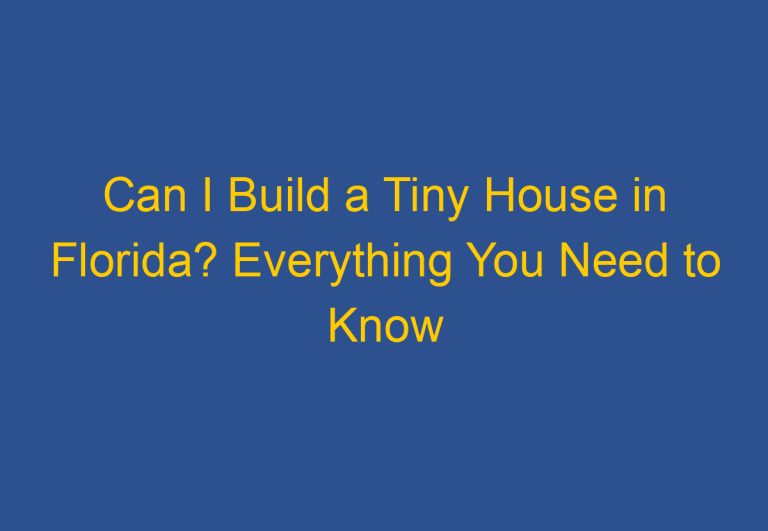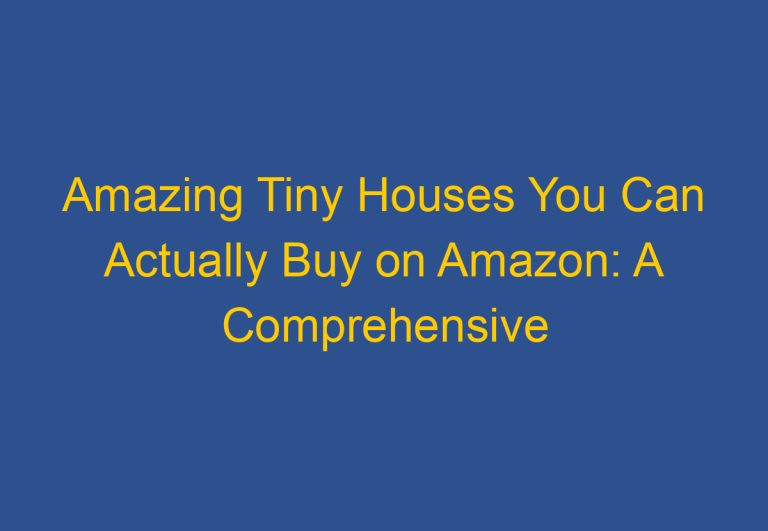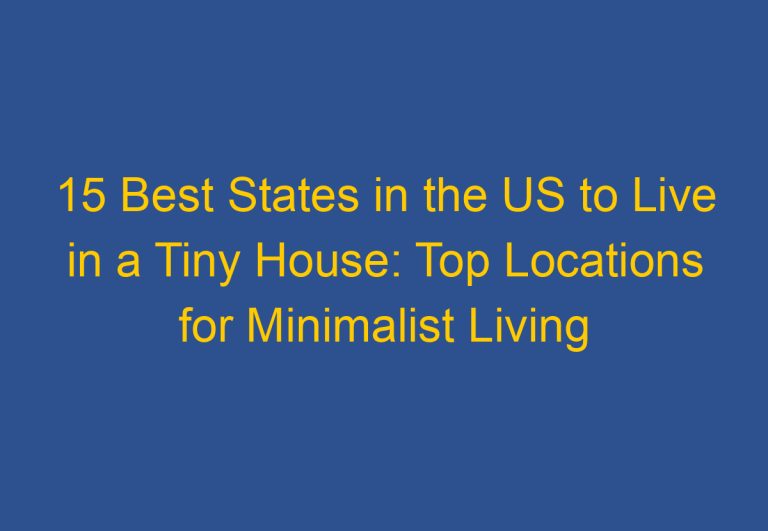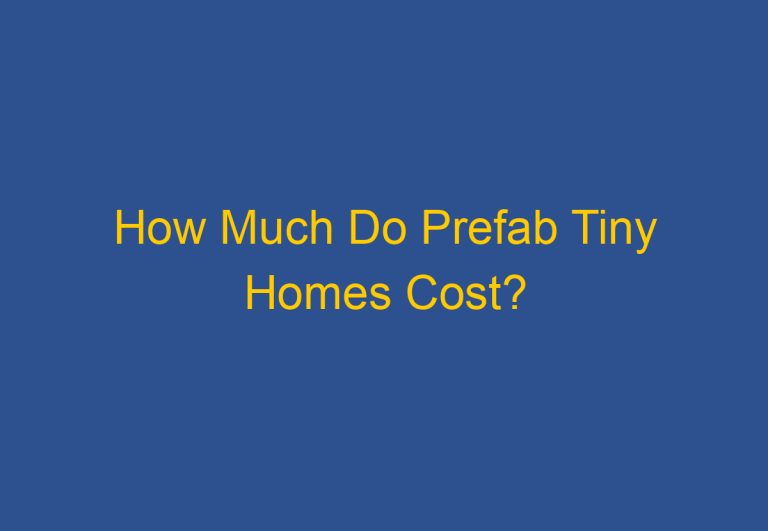Are Tiny Houses Self Contained? Exploring the Features and Benefits of Self-Contained Tiny Homes
Tiny houses have become increasingly popular in recent years as people look for more affordable and sustainable living options. These small homes are typically less than 400 square feet and can be built on or off-grid. However, one question that arises is whether tiny houses are self-contained.
A self-contained tiny house is one that has all the necessary amenities to function independently without relying on external resources. This includes having its own power source, water supply, and waste management system. While some tiny houses are designed to be self-contained, others may require hookups to external resources such as electricity, water, and sewage.
When considering whether a tiny house is self-contained, it’s important to understand the different types of tiny houses available. Some tiny houses are built on trailers and are designed to be mobile, while others are built on a foundation and are meant to be stationary. Additionally, some tiny houses are DIY projects, while others are professionally built. The level of self-containment will vary depending on the type of tiny house and how it was built.
Understanding Tiny Houses
Defining the Tiny House Movement
Tiny houses are small, self-contained dwellings that are typically between 100 and 400 square feet in size. They are designed to maximize space while minimizing unnecessary features, allowing for a simpler, more minimalist lifestyle. The tiny house movement has gained popularity over the years as people seek to downsize and live more sustainably.
Benefits of Living in a Tiny Home
One of the main benefits of living in a tiny home is the freedom it provides. Tiny homeowners have the ability to move their homes to different locations, allowing for a more flexible lifestyle. In addition, tiny homes are often more affordable than traditional homes, making them an attractive option for those looking to save money on housing.
Living in a tiny home can also lead to a simpler, more minimalist lifestyle. With limited space, homeowners are forced to prioritize what they truly need and eliminate unnecessary possessions. This can lead to a sense of freedom and a more intentional way of living.
Comparing Tiny Homes to Traditional Homes
When comparing tiny homes to traditional homes, there are a few key differences to consider. While traditional homes offer more space and amenities, they often come with a higher price tag and require more maintenance. Tiny homes, on the other hand, are more affordable and require less upkeep.
Another difference to consider is the impact on real estate. Tiny homes can be placed on smaller plots of land, allowing for more efficient use of space. This can be beneficial in areas where real estate is in high demand. However, some areas may have zoning laws that restrict the placement of tiny homes.
Overall, the tiny house movement offers a unique and sustainable way of living. By prioritizing simplicity and minimizing possessions, homeowners can enjoy a more intentional and fulfilling lifestyle.
Self-Sufficiency in Tiny Homes
Living in a tiny home can offer a unique opportunity for self-sufficiency. In this section, we will explore the different aspects of self-sufficiency that are possible in tiny homes.
Off-Grid Capabilities
One of the most significant advantages of tiny homes is their off-grid capabilities. Being off-grid means that a tiny home can function independently of municipal utilities, such as water, electricity, and sewage. This independence can be achieved through the use of solar panels, rainwater collection, and composting toilets.
Energy and Water Systems
The energy and water systems in a tiny home are critical components of its self-sufficiency. Many tiny homes use solar power to generate electricity, which can be stored in batteries for later use. Water systems in tiny homes can also be self-contained, with rainwater collection and filtration systems providing water for daily use.
Design and Customization
Tiny homes are highly customizable, and this flexibility can be used to achieve self-sufficiency. For example, a tiny home can be designed to maximize natural light, reducing the need for artificial lighting. The use of energy-efficient appliances and materials can also help to reduce energy consumption.
Permits and Regulations
It is essential to consider permits and regulations when building a self-sufficient tiny home. Some areas have specific regulations regarding the use of composting toilets or autonomous sewage systems. It is important to research these regulations before building a tiny home.
In conclusion, self-sufficiency is an achievable goal in tiny homes. Through the use of off-grid capabilities, energy and water systems, and thoughtful design and customization, a tiny home can function independently of municipal utilities. It is important to research local regulations and permits to ensure that the tiny home is built in compliance with local laws.
Frequently Asked Questions
What are the essential features of a self-sufficient tiny home?
A self-sufficient tiny home is designed to be off-grid and independent of traditional utilities. It should have its own power source, such as solar panels or a generator, and a water source, such as a well or rainwater collection system. It should also have a way to handle waste and sewage, typically through a composting toilet or other alternative system. Additionally, a self-sufficient tiny home should be well-insulated and designed for energy efficiency to reduce energy consumption.
How do off-grid tiny homes handle waste and sewage?
Off-grid tiny homes typically use composting toilets or other alternative systems to handle waste and sewage. Composting toilets use natural processes to break down waste into compost, which can be used as fertilizer. Other alternative systems may use incineration or evaporation to eliminate waste. It is important to note that these systems require regular maintenance and proper use to ensure they function properly.
What are the legal requirements for setting up a permanent tiny home?
The legal requirements for setting up a permanent tiny home vary depending on the location. In some areas, tiny homes may be considered accessory dwelling units and subject to the same regulations as traditional homes. In other areas, they may be subject to zoning and building codes that restrict their size and placement. It is important to research local regulations and obtain any necessary permits before setting up a permanent tiny home.
How do tiny modular homes compare in sustainability to traditional homes?
Tiny modular homes are generally more sustainable than traditional homes due to their smaller size and focus on energy efficiency. They typically require fewer resources to build and maintain, and their smaller size means they consume less energy and produce less waste. However, it is important to note that sustainability is not just about the size of the home, but also about the materials used, the energy source, and the overall design.
Can tiny homes be easily relocated, and what are the logistics involved?
Tiny homes can be easily relocated, but the logistics involved depend on the size and design of the home. Some tiny homes are built on trailers and can be towed behind a vehicle, while others may require a flatbed truck or other specialized equipment. It is important to consider the cost and feasibility of relocation before choosing a tiny home design.
What are the common challenges faced when living in a small off-grid home?
Living in a small off-grid home can present a number of challenges, including limited space, limited resources, and the need for self-sufficiency. It can also be difficult to maintain a comfortable temperature and manage waste and sewage. Additionally, living off-grid may require a significant lifestyle adjustment and a willingness to embrace a simpler way of life.










